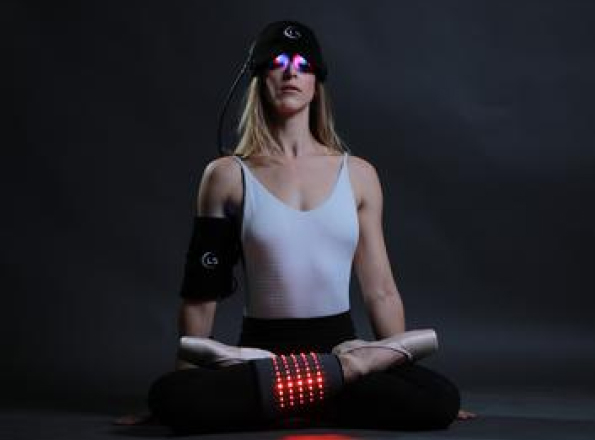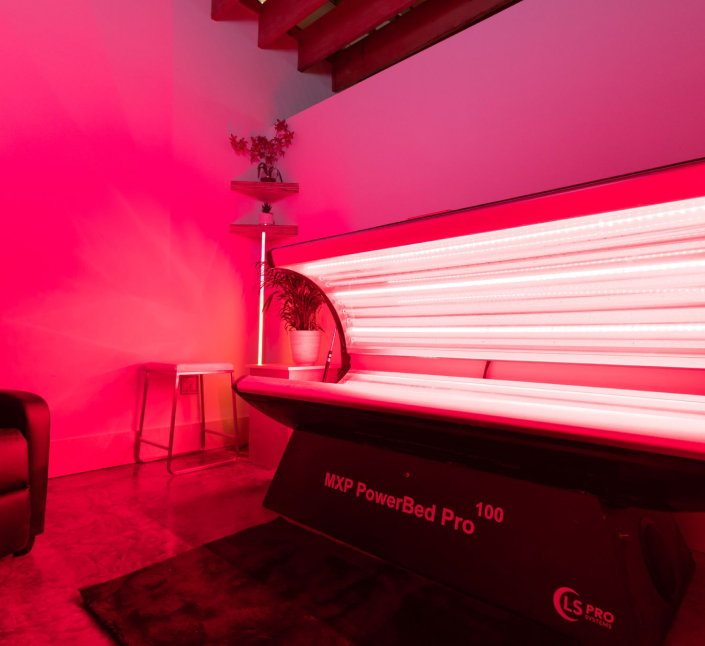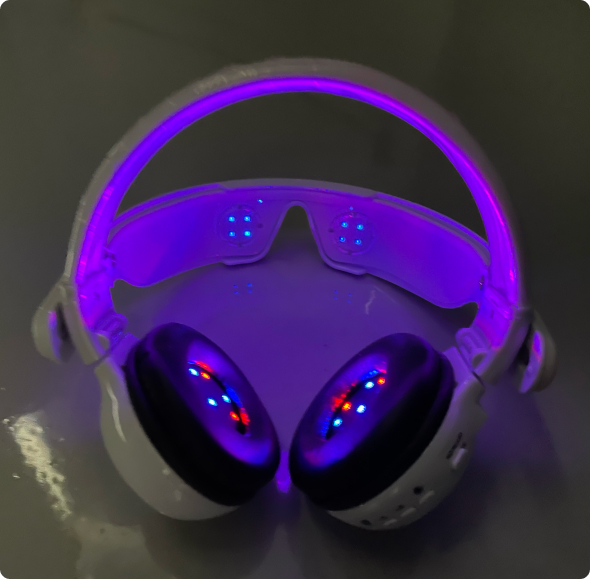Understanding
Red Light
Therapy - Benefits,
Treatments
& Uses
Red light therapy, also known as low-level laser therapy or photobiomodulation, involves exposing the body to low levels of red or near-infrared light. Initially used by NASA to promote plant growth in space, this technology has now made its way into the health and wellness industry.
From improving skin health and accelerating wound healing to reducing inflammation and easing pain, red light therapy has shown promising results in various medical and aesthetic fields.
We're offering this guide for you to dive into the benefits, treatments, and uses of red light therapy, exploring how this non-invasive approach is revolutionizing the way we approach healing and wellness.
Let's shed some light, not just infrared light, on this intriguing therapy.
What's Red Light Therapy and How Does it Work?
Red light therapy (RLT), a form of photobiomodulation, involves the use of low-wavelength red light to treat various physical or dermatological conditions. This innovative therapy aims to serve those seeking non-invasive solutions to enhance their well-being and treat several medical conditions or their symptoms.
By stimulating collagen production, a critical protein for skin elasticity and regeneration, red light therapy supports the body's natural healing processes, potentially reducing wrinkles and improving overall skin tone.
The mechanism behind red light therapy is grounded in its ability to penetrate the skin at varying depths, energizing cells and increasing blood circulation to the treated areas. It specifically stimulates the mitochondria, the powerhouses of the cell, to increase energy.
This process of increasing mitochondrial energy metabolism encourages cellular repair and can lead to various health benefits, including enhanced skin appearance and accelerated healing of wounds.
You'll likely find RLT under several other names, like:
- Photodynamic therapy
- Low-level light therapy
- Low-intensity Red Light
- Cold laser therapy
- Low-power laser therapy
- Low-level laser therapy or low-level laser light therapy
- Soft laser therapy
- Non-invasive LED treatment (as it uses mostly LED lights to emit the light)
Or even the more verbose atraumatic photobiomodulation treatment. No matter the name used by the clinic or wellness center you visit, it presents a means to help patients with their health in non-invasive ways when other treatments aren't available or have failed.
Are LED Light Therapy and Red Light Therapy The Same?

Although LED light therapy and red light therapy are both commonly used for various health treatments, they are not interchangeable concepts. LED light therapy involves using LED technology to emit a wide range of colors, such as red, blue, and near-infrared, each targeting specific skin concerns with different wavelengths. For instance, blue light is commonly used to address acne.
This method is primarily used for its versatility in treating various skin conditions, such as acne and aging symptoms, by promoting the production of collagen and aiding in the healing process.
Red light therapy, on the other hand, specifically uses a narrow spectrum of red visible light and sometimes near-infrared light. It's often associated with low-level laser therapy (LLLT), a technique that applies low-intensity lasers or light-emitting diodes (LEDs) to the surface of the body. Red light therapy is particularly noted for its effectiveness in deeper tissue healing and its ability to enhance cellular function—benefits that are crucial for those in healthcare and wellness professions seeking to provide comprehensive treatment options.
In essence, while LED light therapy can include infrared, Blue LED Lights, low-level laser light therapy, or RTL as part of its spectrum, red light therapy is exclusively focused on this wavelength, offering unique therapeutic benefits.
Overall Benefits of Red Light Therapy
RTL is thought to stimulate cellular function and energy, leading to a spectrum of benefits that cater to both physical and mental health. This therapeutic approach aids in muscle recovery, enhances joint mobility and promotes wound healing through increased blood flow and tissue oxygenation.
Additionally, several studies have even shown that it has a positive effect on the health of the skin.
Enhanced Muscle Recovery and Performance
One significant benefit of red light therapy is its ability to enhance muscle recovery and improve athletic performance. This innovative treatment modality utilizes specific wavelengths of light to penetrate deep into tissues, stimulating cellular function and regeneration. Athletes and individuals engaged in physical activities greatly benefit from this, as it helps to reduce muscle fatigue and soreness after intense workouts.
By boosting mitochondrial energy metabolism, red light therapy aids in the more efficient production of ATP (adenosine triphosphate), the energy currency of the cell. This increase in cellular energy not only accelerates the muscle recovery process but also enhances overall performance by improving endurance and strength.
Moreover, the application of red light therapy post-exercise can lead to quicker restoration of muscles, allowing for more frequent and intensive training sessions. This aspect is particularly valuable for those dedicated to serving and supporting others through physical means, such as sports coaching, physical therapy, and personal training.
Increased Blood Flow and Tissue Oxygenation for Wound Healing
Enhanced tissue oxygenation and increased blood flow, critical elements in wound healing, are among the pivotal benefits of red light therapy.
By enhancing blood flow, red light therapy ensures that more oxygen and nutrients reach the wound site. This is crucial for repair and regeneration, as increased nutrient supply supports cellular activities essential for tissue repair.
Moreover, red light therapy aids in reducing inflammation, a common impediment in the wound-healing process. By moderating the inflammatory response, this technology helps to create a more conducive environment for wounds to heal efficiently.
The non-invasive nature of red light therapy makes it an attractive option for those seeking safe and effective treatment methods without the side effects often associated with pharmaceutical interventions.
For healthcare providers and caregivers dedicated to improving patient outcomes, red light therapy offers a promising tool. Its ability to expedite wound healing not only enhances patient care but also reduces the duration of recovery, allowing individuals to regain their quality of life more swiftly.
Integrating this technology into treatment protocols can significantly impact the healing journey of numerous patients.
Enhanced Joint Health and Mobility
Red light therapy also offers significant benefits for joint health and mobility. This innovative treatment method has the potential to alleviate chronic joint conditions such as arthritis, tendonitis, carpal tunnel syndrome, and other musculoskeletal conditions.
By penetrating deep into tissues, red light therapy stimulates collagen synthesis (production of collagen,) a vital protein that helps maintain the integrity of cartilage. This process not only aids in cushioning joints but also enhances their overall functionality, potentially restoring mobility and reducing pain.
Furthermore, the therapeutic effects of red light include fostering the healing of tissues surrounding joints and reducing joint pain or discomfort.
For individuals grappling with arthritis, this can mean less joint stiffness and overall pain relief, allowing for greater mobility and daily function.
Similarly, for those suffering from fibromyalgia, a condition characterized by widespread musculoskeletal pain, red light therapy can serve as a crucial tool in pain management strategies. It aids in relaxing muscles and diminishing the painful sensations frequently experienced, providing a comforting relief.
This is also particularly beneficial for those with sports injuries or age-related degeneration, where accelerated recovery is crucial. Red light therapy promotes a non-invasive, drug-free approach to enhancing joint health, making it an appealing option for those seeking holistic methods to care for their body.


Improved Mood, Sleep Quality, and Mental Well-Being
Red light therapy is increasingly recognized for its ability to improve mood, sleep quality, and overall mental well-being.
By exposing the body to low wavelengths of red light, this therapy helps stimulate the body's serotonin production, a key hormone that stabilizes mood and fosters calmness and focus.
Further, red light therapy contributes significantly to better sleep quality. It does this by assisting in the regulation of melatonin, a hormone that governs sleep cycles. Other forms of light therapy have even been found to help with Seasonal Affective Disorder (SAD), for example.
Adequate sleep is essential for mental clarity, emotional stability, and overall health, making this therapy a valuable tool for those who aim to support and uplift others through their professional roles and personal lives. Some studies even found it successful in improving sleep and mental health in patients with traumatic brain injuries.
Moreover, overall mental well-being is enhanced through the reduction of stress and anxiety levels, providing a sense of peace and resilience and even improving cognitive function. For individuals in demanding roles, utilizing red light therapy can be a supportive measure to maintain high levels of mental and emotional health, ensuring they can continue to deliver care and support effectively.
Reduce Cold Sores from Herpes
Red light therapy has been observed to enhance cell function, which can bolster the skin's defense mechanisms against the herpes simplex virus responsible for cold sore outbreaks.
For individuals suffering from recurrent cold sores, introducing red light therapy into their care regimen can be a game-changer. The therapy not only helps in soothing the painful symptoms associated with cold sores but also accelerates the healing process, reducing the duration of an outbreak. Moreover, regular treatments can potentially decrease the occurrence of future outbreaks, providing a sense of relief and control over this chronic condition.
Stimulates Fibroblasts and Collagen Production
By energizing fibroblasts—cells crucial for the regeneration of connective tissues, red light therapy enhances their ability to produce collagen. This protein is fundamental to maintaining the strength and elasticity of human skin.
Increased collagen production can lead to numerous skin health benefits, including improved skin texture, lowering skin roughness, reduced wrinkles, and enhanced skin firmness. These improvements are not only beneficial for aesthetic appeal but also support the skin's integral role as a protective barrier.
Furthermore, by strengthening connective tissue, red light therapy aids in the overall structural integrity of the body, supporting other tissues and organs.
This method offers a treatment of skin tissue to individuals without the need for invasive procedures, aligning with a holistic approach to health and wellness.
Treat Inflammatory Conditions
For individuals suffering from chronic pain or acute inflammation, the benefits of red light therapy can be transformative, enabling a better quality of life without the dependence on pharmaceuticals.
Red light therapy effectively reduces inflammation by modulating biochemical pathways that decrease the production of inflammatory cytokines within the blood vessels. By influencing these pathways, red light therapy contributes not only to reducing inflammation but also to overall skin improvements, enhancing both the appearance and health of the skin.
Incorporating red light therapy into treatment plans has shown promising results, with many patients reporting significant improvements in their symptoms. Healthcare providers can consider this therapy as a part of an integrated approach to manage and treat inflammatory conditions effectively by using the body's natural healing processes and encouraging quicker recoveries.
Treatment for Several Skin Conditions
Red light therapy is frequently utilized to treat a variety of skin conditions, including acne, psoriasis, and eczema. Red light therapy uses red light wavelengths to penetrate human skin, and it can promote healing and rejuvenation at a cellular level.
For those suffering from acne, red light therapy can be particularly beneficial. It can act as an acne treatment because it reduces the inflammation associated with acne and decreases the production of oils that lead to breakouts. Furthermore, by enhancing cellular function for tissue repair growth, red light therapy helps improve the skin's overall texture and tone, which are often compromised in various skin conditions. For this reason, it's also used as a treatment for leveling out tone and removing dark spots.
Some studies also suggest it as a valuable remedy for the painful side effects of skin cancer treatment, although more research is still needed.
The appeal of red light therapy in a clinical or therapeutic setting is its non-invasive nature and the absence of harsh chemicals, making it a safe alternative for long-term use. Healthcare providers aiming to offer compassionate, effective treatment options might find red light therapy devices an indispensable addition to their practice, especially for clients struggling with persistent skin issues.
Help Heal Scars and Psoriasis
Building on its benefits for general skin health, red light therapy also shows promise in healing scars and managing symptoms of psoriasis. This non-invasive treatment can be a beacon of hope for individuals yearning for relief from chronic skin conditions that not only affect the body but also impact emotional well-being.
For those suffering from scars, RLT can translate into smoother skin texture and a reduction in the visibility of scar tissue. The therapy enhances blood circulation and reduces inflammation, which are crucial factors in the body's natural healing processes.
In the case of psoriasis, a disorder characterized by excessive skin cell growth leading to thick, red, and scaly patches, red light therapy helps by normalizing cell growth and reducing inflammation. Regular sessions can significantly ease the discomfort associated with psoriasis, offering not just physical but also psychological relief.
This gentle yet effective approach serves as a testament to the power of advanced technology in fostering healing and providing care to those in need.
Helps Remove Wrinkles, Fine Lines, and Aid Skin Rejuvenation
Red light therapy is known for its ability to enhance skin tone and texture by promoting collagen production and cellular rejuvenation. By stimulating the mitochondria in skin cells, which leads to a collagen increase, this therapy helps maintain skin elasticity and firmness, resulting in a smoother and more even complexion.
Regular sessions of red light therapy in human studies have been shown to reduce the appearance of wrinkles and fine lines, rejuvenate the skin, and impart a healthy glow, making the skin appear more youthful and radiant. This non-invasive treatment is a great option for those seeking to improve their skin without resorting to harsh chemicals or invasive procedures.
Potential to Stimulate Hair Growth
Several studies suggest that red light therapy may also encourage hair growth by increasing blood flow to the scalp and stimulating hair follicles. This process is believed to activate the follicles from their dormant state into an active growth phase.
Research indicates a significant potential for red light therapy in treating conditions like androgenetic alopecia—commonly known as pattern hair loss—both in men and women. Studies reveal that patients receiving red light treatment often experience an increase in hair density and a slowing down of hair loss. The therapy is considered a safe, non-invasive alternative to traditional hair growth methods, which can involve chemicals or surgical procedures.

The Red Light Therapy Devices Typically Used in Treatment
Red light therapy devices are designed to target specific areas of the body, each tailored to maximize the therapy's effectiveness. Options range from hand-held units for localized application to larger, more immersive setups such as infrared therapy beds and ultra-low infrared saunas.
These varied devices ensure that treatment can be customized to meet the specific health and wellness needs of each individual.
Targeted to Specific Areas of the Body
To effectively target specific areas of the body, various devices designed for red light therapy are employed, each tailored to treat different physical conditions and needs. For instance, handheld devices are ideal for treating smaller, more specific areas like joints or the scalp. These devices allow for precise application, ensuring that the therapeutic light directly impacts the area requiring treatment.
Additionally, face light masks embedded with red light-emitting diodes (LEDs) are particularly beneficial for patients seeking facial rejuvenation. These LED masks help reduce signs of aging, such as wrinkles and fine lines, by promoting collagen production and improving skin elasticity. The effects of such targeted treatment can lead to improved skin texture and overall youthful appearance. They can also switch to green or blue light to provide other benefits when using LED light therapy, like the treatment sessions at ReEnergized.
Larger panels are also used, especially useful for broader areas like the back or chest. By emitting red light over a wider surface area, these panels can address issues such as muscle pain or skin conditions over larger regions, making them an efficient tool for practitioners aiming to provide comprehensive care.
Each of these devices plays a crucial role in delivering targeted red light therapy, addressing specific patient needs with precision, thereby enhancing the effectiveness of the treatment and maximizing the health benefits for those they serve.
Through Red Light or Infrared Therapy Bed
In addition to handheld devices and face masks, red light therapy beds offer a comprehensive solution by enveloping the entire body in therapeutic light. These specialized devices are designed to maximize the benefits of red light therapy by allowing simultaneous exposure across various parts of the body. This method is particularly beneficial for individuals seeking an efficient and effective means of applying the healing and restorative properties of red light on a larger scale.
Red light therapy beds resemble traditional tanning beds but function quite differently. Instead of emitting UV rays, these beds use LEDs to deliver safe, concentrated wavelengths of natural light directly to the skin's surface and deeper tissues. This exposure helps stimulate cellular processes that can lead to enhanced skin health, pain relief, and overall wellness.
The design of these beds ensures that light is distributed evenly, making it possible to treat the entire body without the need to reposition the source manually. They also offer a relaxing spa experience, adding value to the service that already gives the patients improvements in skin feeling and health.
Sessions in Ultra Low Infrared Sauna
Ultra-low infrared saunas represent another category of devices employed in red light therapy treatments, providing a unique method of exposure through deep tissue penetration. These saunas utilize infrared light to gently elevate body temperature and simulate natural sunlight without the dangers of UV rays, thereby allowing deeper penetration of red light into the tissues.
During therapy sessions in an infrared sauna, the controlled environment allows for precise temperature regulation, ensuring that the benefits of red light therapy are maximized without discomfort. This setting is particularly conducive to fostering relaxation while the body absorbs the therapeutic red wavelengths, promoting healing and rejuvenation at a cellular level.
Red light therapy in an infrared sauna can be tailored to individual needs, making it a versatile tool in health and wellness regimes. Whether the aim is to alleviate muscle tension, reduce inflammation, or boost overall vitality, these sessions provide a sanctuary where one can focus on self-care and recovery.
Side
Effects
and Who
Should
Avoid
Red Light
Therapy
Although red light therapy is generally considered safe and does not produce any damaging UV rays, certain individuals should exercise caution or avoid it altogether due to potential side effects.
Among the adverse short-term and long-term effects possible:
- Eye strain or discomfort: Prolonged exposure to bright lights, including red and LED lights, may cause eye strain or discomfort. It is important to use proper eye protection when undergoing light therapy treatments. If using a light mask, this warning is doubly important. The treatment time should be minimal and low-powered.
- Skin irritation: Redness or irritation of the skin can occur in certain people when they are exposed to red or LED lights. People who already have sensitive skin or a history of skin diseases may be more prone to this.
- Migraines and Headaches: Light therapy treatments have the potential to cause migraines and headaches in certain people. The lights' intensity or the wavelengths employed might be to blame.
- Insomnia or disrupted sleep patterns: Light therapy treatments, particularly when administered at night, have the potential to interfere with regular sleep cycles, which could result in insomnia. If you want to keep your circadian rhythms intact while using light treatment, you need to time it correctly.
- Hyperpigmentation: Excessive exposure to specific light wavelengths used in red or LED light treatment can, in extremely rare instances, cause changes in human skin pigmentation or hyperpigmentation. People of color with darker skin tones are disproportionately affected by this.
Light therapy may have long-term dangers and side effects that vary from person to person depending on their health status and skin type, therefore, it is best to talk to a doctor or dermatologist before beginning treatments.
Light therapy may have long-term dangers and side effects that vary from person to person depending on their health status and skin type, therefore, it is best to talk to a doctor or dermatologist before beginning treatments. There are also certain individuals who are advised to avoid RTL or any type of LED light therapy:
- Individuals with a history of skin cancer should exercise caution when considering red light therapy. While it can help alleviate some side effects of cancer treatments, those currently undergoing treatment or with a history of cancer should seek medical advice before using this therapy. The interaction between red light therapy and cancerous cells is not fully understood, so careful management is necessary to avoid unintended consequences.
- People with photo-sensitive skin conditions should also be cautious when using red light therapy, as exposure to light may aggravate their skin condition.
- Individuals with darker skin tones should adjust the duration of their red light therapy sessions to avoid potential side effects like hyperpigmentation.
- Those with retinal disorders must ensure they use proper eye protection during red light therapy sessions to prevent any harm to their eyes. Without adequate safeguards, there is a risk of retinal damage or other eye-related issues. Individuals with light-sensitive conditions, including retinal disorders, should either use specialized eye protection or refrain from using red light therapy, especially light masks or LED masks.
By being fully informed, individuals can harness the benefits of red light therapy while minimizing potential risks.

At-Home Red Light Therapy Devices: Are They Safe?
Safety concerns regarding at-home red light therapy devices have prompted scrutiny, particularly when compared to the more powerful equipment used in professional settings. The core issue often revolves around the efficacy and safety of these low-powered at-home devices. While professional-grade machines are rigorously tested and adhere to stringent safety standards, the same level of oversight is not always applied to consumer models.
Many at-home devices may not deliver the intensity needed to achieve the therapeutic benefits seen in clinical studies. This discrepancy can lead individuals to question whether they are receiving any genuine health benefits or merely experiencing a placebo effect. Additionally, the lower power of these devices might require prolonged exposure to see results, which could potentially lead to unforeseen long-term effects or skin damage due to overuse or not using the correct power levels depending on different skin types, for example.
For individuals keen on helping themselves or others through this modality, it is crucial to approach at-home red light therapy with caution. Researching products, understanding their specifications, and possibly consulting with health professionals can help mitigate risks.
While these devices offer the convenience of treatment at home, their safety and effectiveness are sometimes overshadowed by the superior capabilities of professional equipment.
Book WIth ReEnergized And Feel The Benefits of Red Light Therapy
At ReEnergized, we invite you to explore the potential health benefits of red light therapy. Our state-of-the-art facility is dedicated to harnessing the power of light to foster healing and improve overall wellness. Red light therapy uses specific wavelengths of light to penetrate the skin, offering an array of health advantages without the need for invasive procedures.
Our devices are carefully calibrated to ensure safety and efficacy, emitting lights that stimulate cellular energy production and rejuvenate the skin. Regular sessions can lead to improved skin health, reduced inflammation, and enhanced muscle recovery, among other benefits.
At ReEnergized, we believe in empowering our clients to take control of their health, providing a nurturing environment where each individual's care is prioritized.